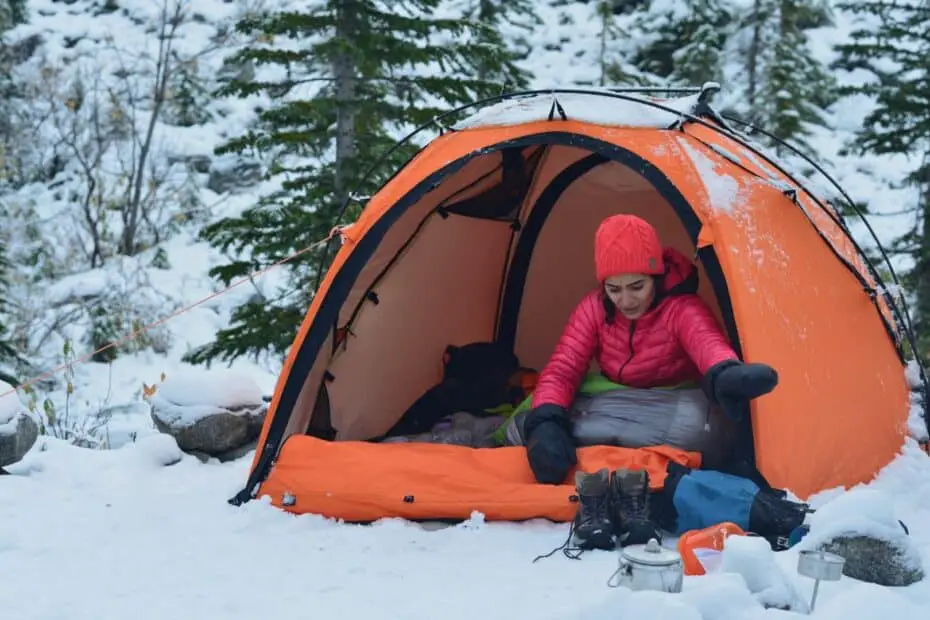There’s no excuse for being cold on a winter camping trip! You just need to choose the right cold weather camping gear and dial in your cold weather camping clothes. Unfortunately that’s easier said than done, but luckily you’ve came to the right place. How do you choose winter camping clothes?
When choosing winter camping clothes, focus on wearing multiple layers. Choose a moisture wicking base layer, insulating middle layer, and waterproof outer shell layer. The base layer keeps you dry, middle layer makes maintains warmth, and outer layer protects you from rain and wind.
Messing up your layers is a surefire way to be cold and wet on a cold weather camping trip. In the rest of this post, I’ll teach you how to layer up and fine tune your winter camping clothes.
Table Of Contents
Winter Camping Clothing: What To Wear Winter Camping
There are two things you need to get right when trying to stay warm on cold weather camping trips. You need to figure out how to layer winter clothes and choose the right winter camping gear.
Layering is the key to staying warm in the winter. You need a moisture wicking inner layer, insulated middle layer, and waterproof/windproof outer clothing layer.
- Moisture Wicking Inside Layer: Your inside layer is what keeps sweat and moisture away from your body. This layer needs to dry fast to reduce the risk of hypothermia. Choose either merino wool or synthetic base layers.
- Insulating Mid Layer: Your insulating mid layer is what allows you to stay warm in extreme cold. Go with heavyweight fleece jacket in moderate temperatures and down or synthetic puffer jacket in freezing temperatures.
- Waterproof/Windproof Outer Shell Layer: Your outer clothing layer is also known as the shell layer. This is the layer that protects you from rain, wind, and snow. It needs to be 100% waterproof and windproof.
I won’t go into detail about choosing winter camping gear in this post, but here’s a brief overview. You need a sleeping bag that’s 15°F warmer than expected nighttime temperatures, a 5+ R-Value sleeping pad, and suitable tent.
It’s only a few degrees warmer inside a tent, but you do need to consider snowfall. A 3-Season tent can only handle about 4″ of snow. Either knock the snow off throughout the night or go with a sturdy 4-Season winter tent.
Moisture Wicking Inner Layer (aka Base Layer)
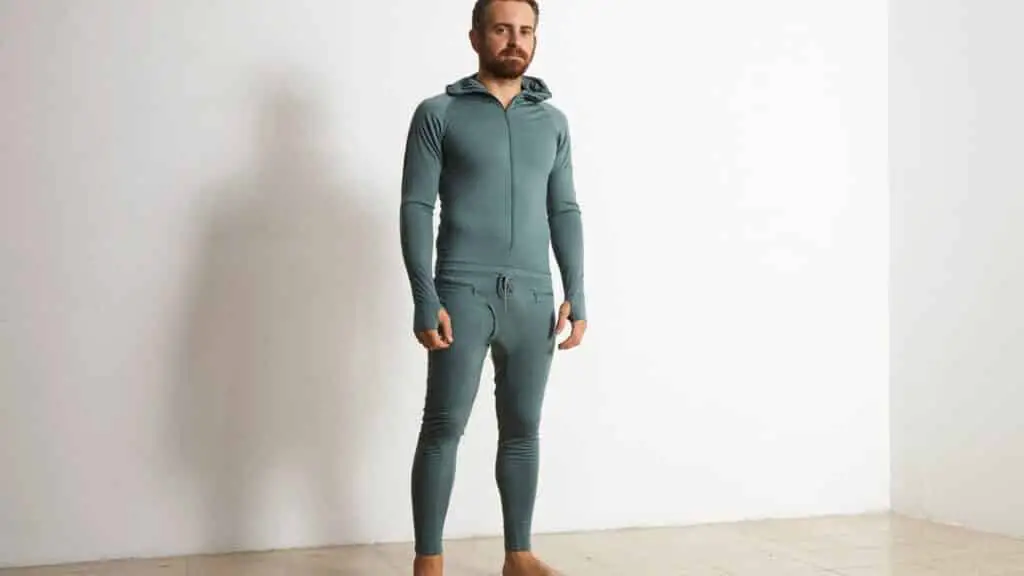
You need to choose moisture wicking fabrics for your inner layer. The inside layer plays a secondary role of helping you stay warm, but it’s primary purpose is to keep your clothes dry. You need to choose fabrics that dry fast, cutting down sweat, and exterior moisture.
What does moisture wicking mean?
There are two primary choices for your inner layer: merino wool or synthetic fabrics (polyester or nylon). Merino wool is better at regulating temperatures(even when wet), but synthetics are a cheaper alternative.
1) Merino Wool or Synthetic Socks
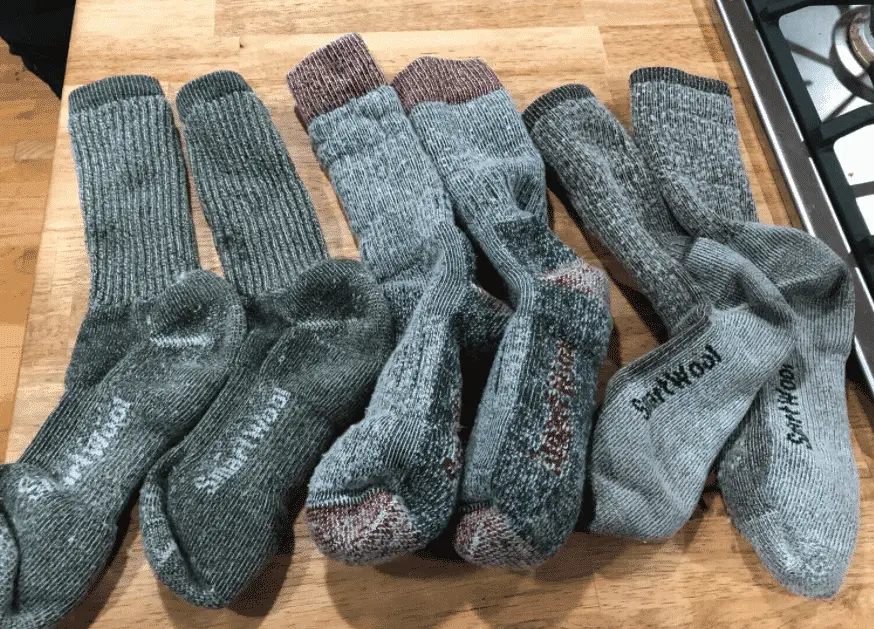
Let’s start off this section by stating a simple fact. Never wear cotton socks on a winter camping trip! Cotton is notoriously bad at dealing with sweat and moisture. There’s a serious risk of frostbite in the winter, so always choose moisture wicking socks.
There are two approaches you can take when choosing socks for winter camping. You can either wear socks made out of 100% merino wool or some type of insulated synthetic/wool blend. Which option is best for you depends on your budget and the insulation in your hiking shoes/boots.
- Merino Wool Socks: Merino wool socks are by far the best choice for keeping your feet warm. They’re extremely warm, wick moisture away from your skin, dry fast, maintain warmth when wet, and can be worn multiple days without smelling. A high quality pair of merino wool socks is more expensive (my favorite), but your feet will be much warmer (less risk of frostbite).
- Thermal Synthetic Socks: Synthetic insulated socks are cheaper, but quality/warmth is all over the place. I’ll explain more below, but most synthetic socks use a blend of acrylic, polyester, nylon, and sometimes wool (for added insulation). Synthetic socks are great at wicking moisture, but warmth depends on the blend used and insulation in your boots.
Merino Wool Socks (The Best Choice)
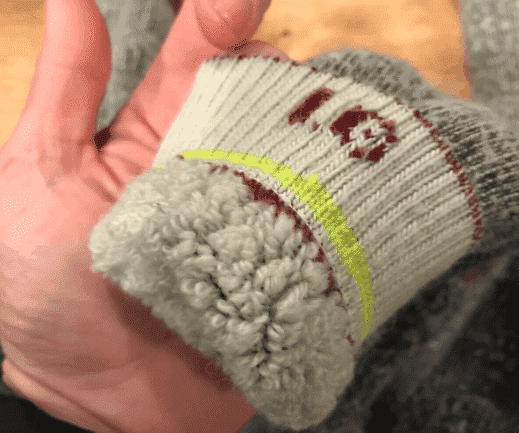
Merino wool socks are by far the best choice for keeping your feet warm in the winter! Actually it doesn’t matter what time of year your camping. Most people don’t realize that wool works just as good in the summer as it does in the winter. Here’s a quick list of the benefits of wearing merino wool socks.
Honestly, I wouldn’t even consider wearing thermal synthetic socks in the winter. Wool socks (I like Smartwool) are much warmer and better at regulating temperatures when wet. Synthetic socks will probably work if you’re wearing 200g insulated hiking boots, but there’s a much higher risk of frost bitten toes.
Wool socks are slightly more expensive than Synthetic, but it’s not fair to do a side by side price comparison. Yes merino wool socks are $5-$10 more expensive than synthetics, but you can wear the same pair of socks multiple days in a row.
I go on multiple week backpacking trips and only carry 2 pairs of Smartwool Socks. You should probably wash them occasionally, but you won’t have to buy/carry as many pairs of socks.
Thermal Synthetic Socks
Thermal socks made out of synthetic materials are another option, but I would avoid them. They’re not as good at dealing with moisture and it’s hard to judge how warm they will be. You always know how warm a pair of 100% merino wool socks will be, but you never know what blend will be used in synthetic socks.
There are a lot of great pairs of synthetic thermal socks available, but they all use different blends of materials. So it’s hard to get an idea of how warm they will be without testing them. If you plan on going this route look for a high concentration of Acrylic (80%+) or synthetic wool blend.
Wool/Synthetic blends are a good balance between price and warmth. They’re usually about half the price of wool socks and much warmer than 100% synthetics. The only downside is they won’t be as good at dealing with sweat and exterior moisture.
2) Long Sleeve Moisture Wicking Shirt (Merino Wool or Synthetic)
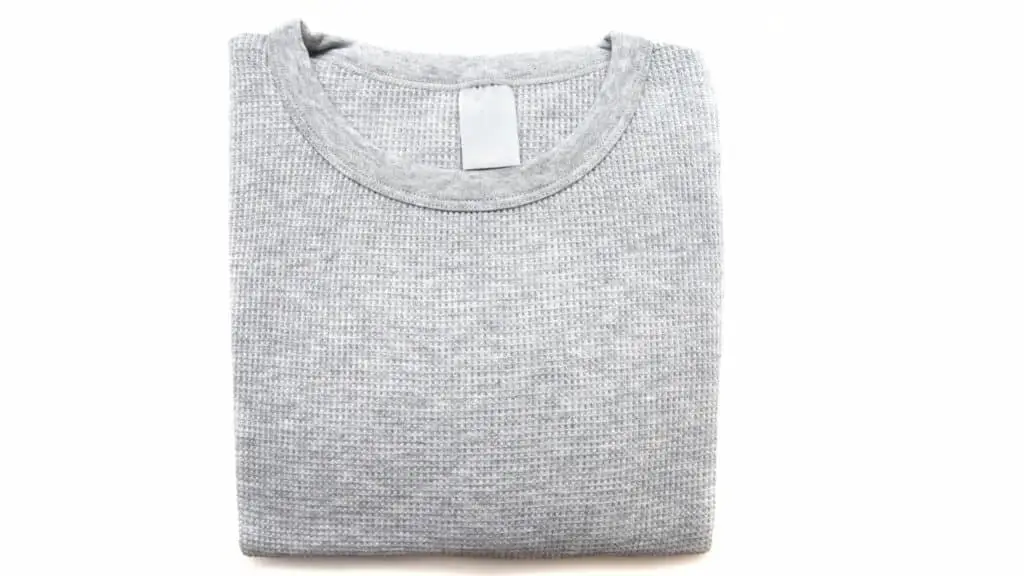
There are two approaches you can take here. You can either wear a long sleeve wool base layer shirt or synthetic long sleeve thermal shirt with a fleece jacket. Fleece jackets are made out of polyester so it also helps wick moisture.
This is one of the places on this list where it’s hard to recommend one choice over the other. Wool is a better option, but it’s hard to justify the price of wool base layers. Merino wool shirts are better at handling sweat and slightly warmer, but that’s not necessary if you dial in your insulating layer and shell layer.
Head over to Amazon and check out the price of long sleeve wool base layers. I wear Smartwool Base Layers, but there are budget friendly options. Go with either Meriwool or Merino.Tech if you want to save some money.
You may also want to check out Goodwill if you’re on a tight budget. That’s where I’ve bought most of my merino wool winter camping clothes. I always find 100% merino wool sweaters for like $8 and they’re usually much nicer than what I could typically afford.
Go With Synthetics If You Won’t Properly Wash Wool
Just understand that you will need to follow special washing instructions with wool clothing. Don’t just toss wool clothes in the washer and dryer. You need to use wool laundry detergent (my favorite), wash in cold water (hand wash or gentle cycle), and hang them up to dry to prevent shrinking.
Go with synthetics if you’re unwilling to follow proper washing directions. You can get 90% of the moisture-wicking benefits with a synthetic thermal base layer without the hassle of washing it properly. The only time you should always go with merino wool is when you’re purchasing socks.
3) Merino Wool or Synthetic Long Underwear
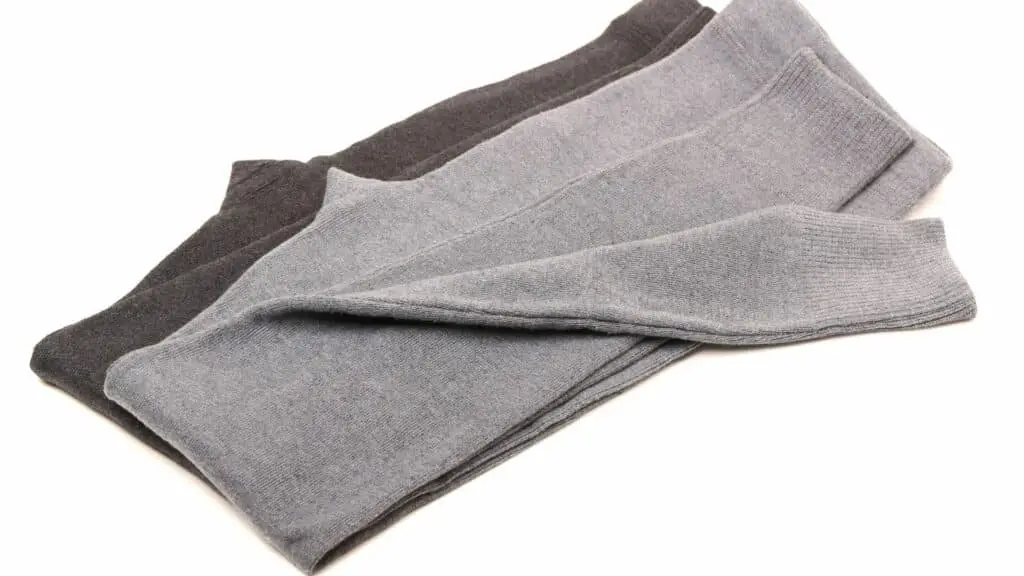
There’s really no right or wrong answer when it comes to long johns. Just make sure you choose a pair of moisture wicking long johns. They need to be made out of either merino wool or synthetic materials (never cotton).
This is another place where you can save some money with synthetic long johns. Merino wool is better at handling sweat and moisture, but synthetic long johns are good enough for most people.
I like the Carhartt Midweight Base Layer Pants, but any 100% synthetic option will work. Just make sure they’re made out of either 100% polyester or some kind of polyester, nylon, and acrylic blend.
The only time you should always go with merino wool is if you have inner thigh chaffing issues. Merino wool can absorb 35% of its weight in water without feeling wet so you’re far less likely to run into chafing issues. I recommend either Meriwool or Merino.Tech base layer pants. Smartwool will be more durable, but they’re far more expensive.
4) Synthetic Hiking Pants and Rain Pants
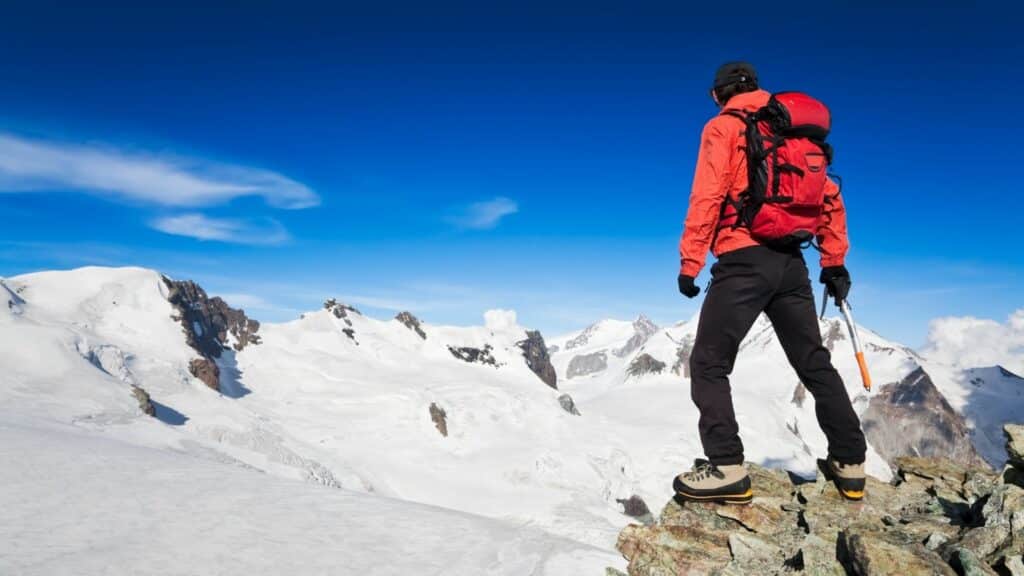
Your synthetic hiking pants will work as your exterior layer in moderate temperatures (32°F or warmer), but you will need insulated hiking pants for freezing temperatures. Go with a pair of moisture wicking synthetic hiking pants, and make sure you wear thermal long johns.
Your hiking pants need to handle moderate amounts of moisture and dry fast. Any pair of 100% synthetic rain pants will work, but I’ve always worn Columbia Hiking Pants. They’re reasonably priced, water resistant, and extremely durable.
I also recommend carrying a pair of waterproof rain pants if you don’t have insulated hiking pants. Rain pants fall more into the outer shell layer category, but I’ll talk about them here. Most people think rain pants are to keep out rain (that’s kind of true), but the main purpose is to provide warmth.
Rain pants are one of the best options for trapping body heat. They may cause you to sweat, but it shouldn’t be that bad in the winter. You shouldn’t have any problems if you’re wearing moisture wicking base layers.
5) Sleeping Clothes
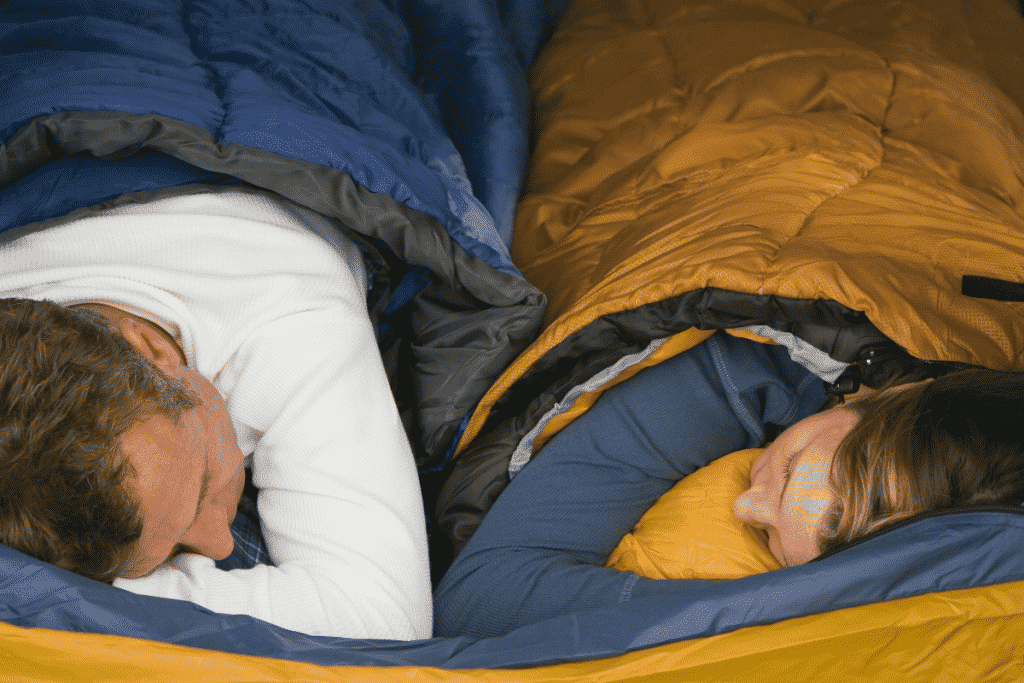
Don’t overthink your sleeping clothes! Your sleeping bag and pad should provide 99% of the warmth, so just wear comfortable clothing to bed. I recommend wearing merino wool socks, a long sleeve moisture wicking shirt, fleece pullover, and sweat pants or pajamas.
I go over camping pajamas in detail in another post!
I hate wearing socks to bed, but always wear warm socks in my sleeping bag. The bottom of your bag has the least amount of insulation so your feet will be cold without them. I’ve never had any issues wearing a pair of Smartwool socks t0 bed.
Your sleeping bag and pad are the most important piece of winter camping gear. The sleeping bag needs to be rated 15°F warmer than expected nighttime temperatures and sleeping pad should be 5+ R-Value.
You can use a sleeping bag liner to pad your bags temperature rating and double up sleeping pads for more warmth. I use a Sea to Summit Thermolite Liner that adds 25°F to my bags temperature rating, but even a cheap Coleman Liner will add 12°F to your bag.
Insulated Middle Layer
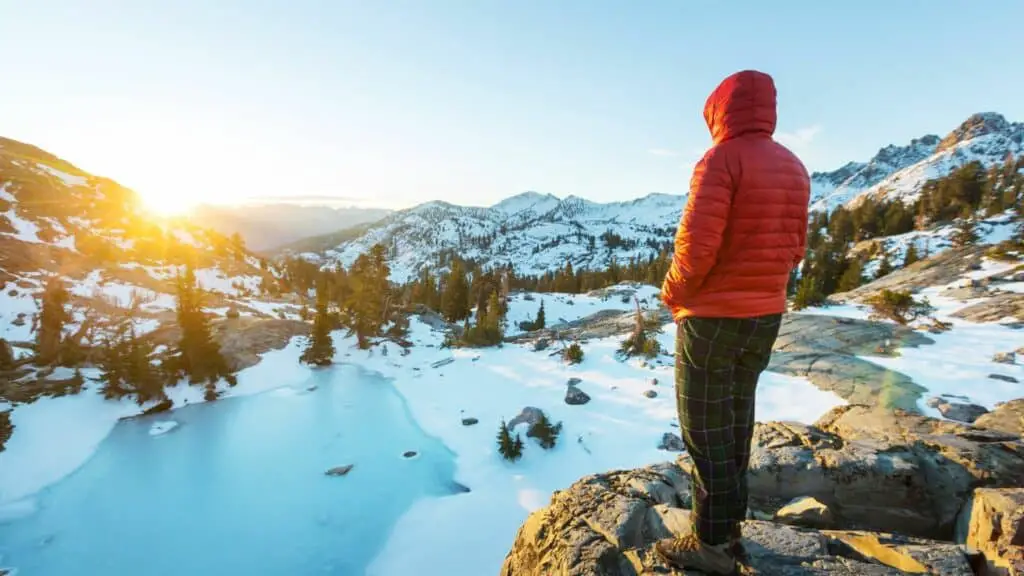
Spend time focusing on your middle layer (aka insulating layer) to stay warm in the winter. The insulating layer is what maintains body heat in freezing weather. It’s one of the most important pieces of camping gear so don’t cheap out on your insulating layer.
There are 3 primary options for a middle layer: fleece jackets, synthetic jackets, and down jackets. You can wear fleece jackets in moderately cold temperatures, but you need a down or synthetic puffer jacket to stay warm in freezing cold temperatures.
1) Fleece Jackets
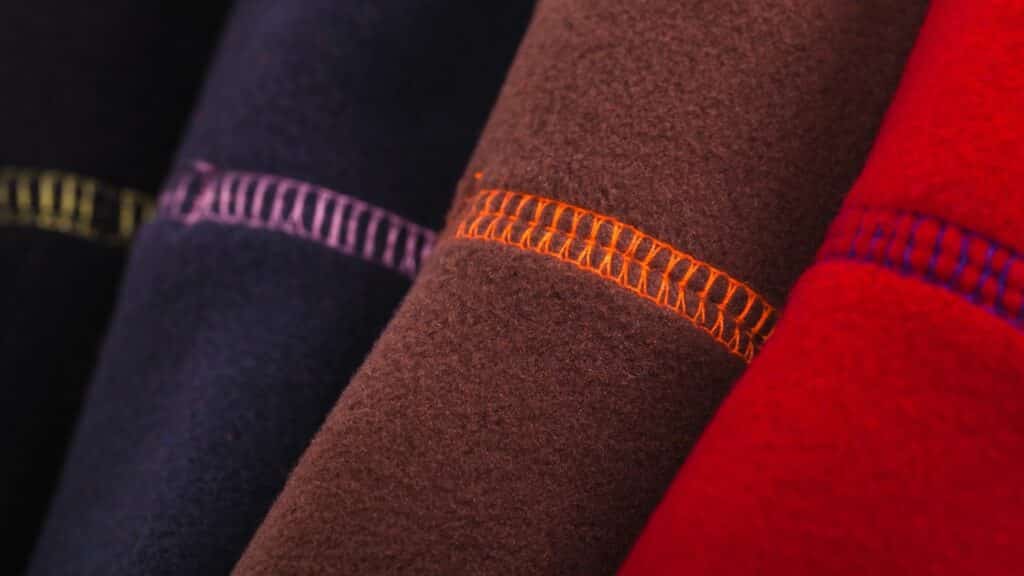
Most people overlook fleece jackets in the winter, but it’s actually actually a great choice for cold weather camping. A heavy fleece jacket provides plenty of insulation and it’s made out of polyester so it resists sweat, rain, and snow.
Fleece jackets come in three different weights: lightweight, midweight, and heavyweight. The amount of warmth in a fleece jacket is measured in grams (100g-300g). Summer jackets are usually 100g and cold weather jackets are 250g-300g.
A 250g fleece jacket like the Columbia Mountain 2.0 Jacket is warm enough for 20°-30°F weather, but you will need to wear a long sleeve moisture wicking shirt under it. You can always toss on your waterproof shell jacket if you get cold.
2) Synthetic Insulated Jackets
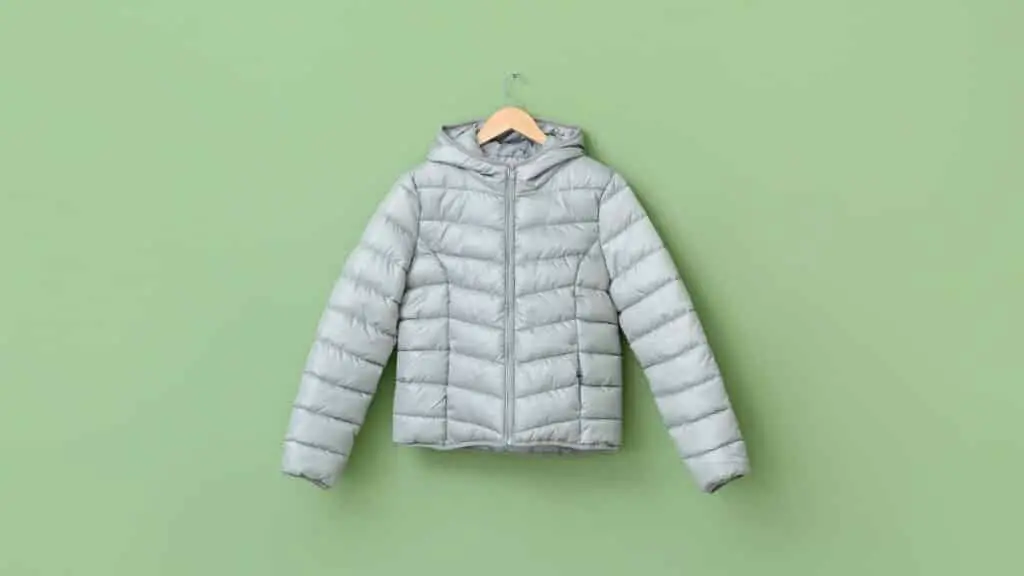
The vast majority of people should choose a synthetic insulated “puffer style” jacket. They’re by far the best choice for cold weather winter camping. Synthetic jackets are cheaper than down, provide plenty of warmth, and maintain temperatures when they get wet.
It can be hard to compare synthetic puffer jackets online. Look for terms like heavy weight, winter rated, and comparisons to down fill power. You need to comb through the reviews to get an idea of how warm the jacket will be.
Amazon Essentials Heavyweight Hooded puffer jacket is an affordable option. You can find lighter jackets from outdoor companies (like Marmot), but plan on spending a small fortune. Try to get an idea of how warm the jackets are by looking at the product weight. Heavier jackets will almost always have more insulation so they’ll be much warmer.
3) Down Insulated Jackets

Most people are under the false impression that down insulation is warmer than synthetic. That’s partially true, but it depends on how much insulation is in the jacket. Down will usually be warmer if you’re comparing 2 similar weight jackets, but synthetics usually have more insulation to increase warmth.
You also need to factor in the fill power of the down insulation. Higher fill power jackets have more loft so they will be warmer with less insulation. If you’re considering a down jacket look for the highest fill power you can afford. A 350 fill power jacket is on the lower end and 500+ fill power is high quality down.
There are 3 major advantages to down jackets. They’re lighter, easier to move in, and more packable. The weight reduction makes down more comfortable, but there is a major issue you need to consider.
Down insulation can’t get wet! It compacts and loses most of its insulating properties. That’s why most people choose synthetic jackets for winter camping. Synthetic insulation maintains warmth when wet, so it’s much safer to wear when you’re camping in cold weather.
Waterproof Outer Layer (aka Shell Layer)
The outer shell layer is what protects your clothes and body from the elements. Your insulating layer isn’t waterproof, so it’s extremely important to carry a 100% waterproof and windproof outer shell.
The shell layer includes your hiking boots, insulated pants, and waterproof jacket. You don’t have to wear your jacket all the time, but it should be easy to access at the top of your pack. Leave your hiking pants on all day, but only toss on your waterproof jacket when the rain or snow picks up.
1) Winter Boots For Hiking And Camping
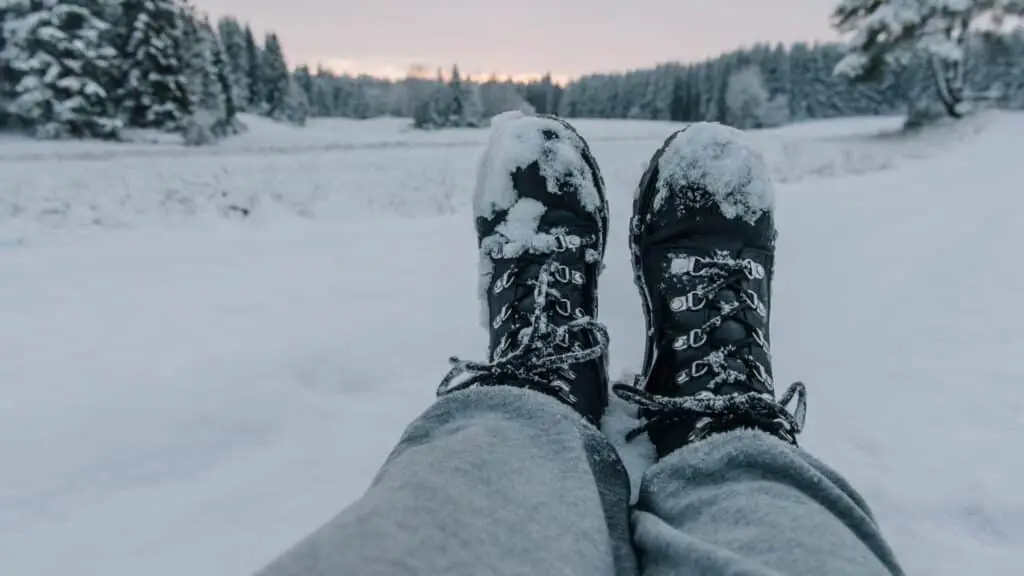
There are three factors you need to consider when looking at winter hiking boots. They need to be waterproof, insulated, and provide traction in slippery conditions. You may be able to get away with regular waterproof hiking boots in mild 32°F+ degree weather (with wool socks), but you’ll need insulated boots in freezing weather.
Most winter campers should go with a pair of waterproof 200g insulated hiking boots. These will be warm enough to handle -20°F temperatures and your feet shouldn’t sweat on cool fall/spring days (up to 40°F).
A pair of 200g boots will be warm enough for 99.99% of people. The only time you would need warmer boots is if you’re camping in extremely cold weather: 400g insulation (-40°F), 600g insulation (-60°F).
You will also need to choose between low, mid or high ankle boots. Low/Mid ankle boots will be more comfortable, but you will need to wear waterproof gaiters in deep snow. High ankle boots provide more ankle support, while keeping out snow, but they’ll be heavier and less comfortable.
Maintaining Traction In Slippery Conditions: Traction For Your Boots
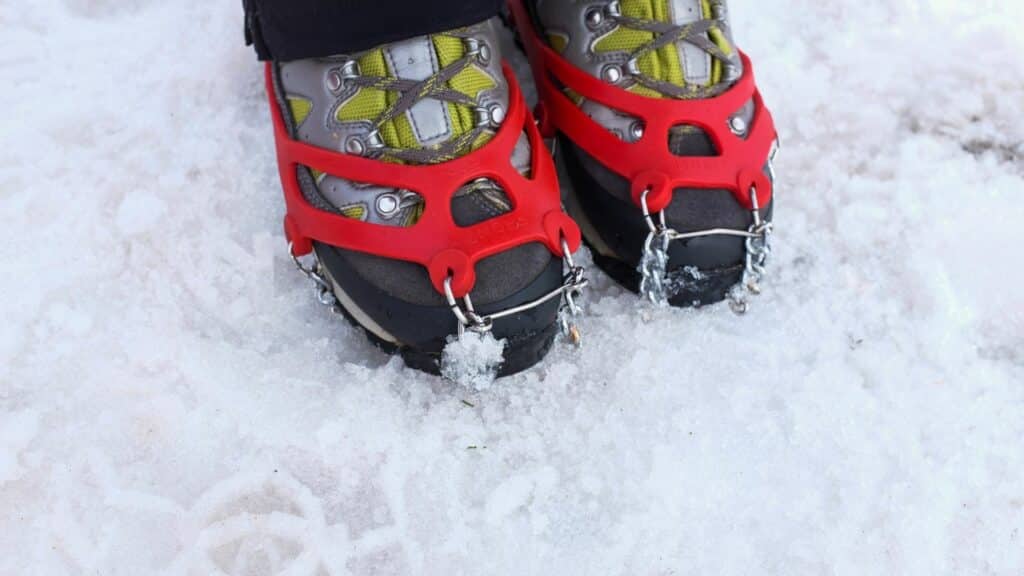
Maintaining your balance can be a challenge when hiking in cold weather. Any pair of insulated winter boots will be work in the snow, but you may need additional traction on icy ground. There are two options to choose: microspikes and crampons.
The vast majority of people should carry a set of micro spikes when camping in the winter. I use Kahtoola Microspikes on my boots. They slide right over your boots and have tiny spikes to provide traction on the ice.
Crampons are a more serious option that are mostly used on mountaineering expeditions. They have longer 1-2 inch spikes which are overkill for general cold weather hiking and camping.
2) Waterproof/Windproof Outer Shell Jacket
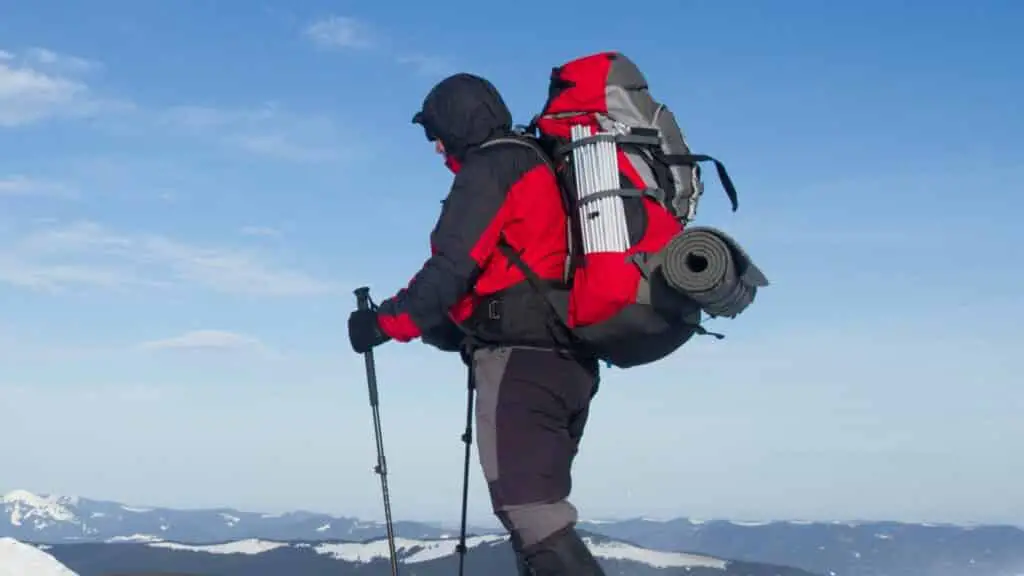
You won’t always need to wear your outer layer, but it’s one of the most important pieces of winter camping gear. This is the jacket that protects the rest of your winter camping clothes from rain and snow.
It doesn’t take long for hypothermia to set in once you get wet, so you need to find a 100% waterproof and windproof jacket. In mild weather this can be a lightweight rain coat, but it’s worth buying an insulated waterproof jacket for freezing weather.
Buy a hooded jacket to protect your head and make sure it’s breathable and comfortable to move in. This is a place where you can save a little bit money. The only time you need to wear a waterproof layer is when it’s raining/snowing or you feel cold. I keep my jacket at the top of my pack and only toss it on when the weather turns.
3) Insulated Hiking Pants
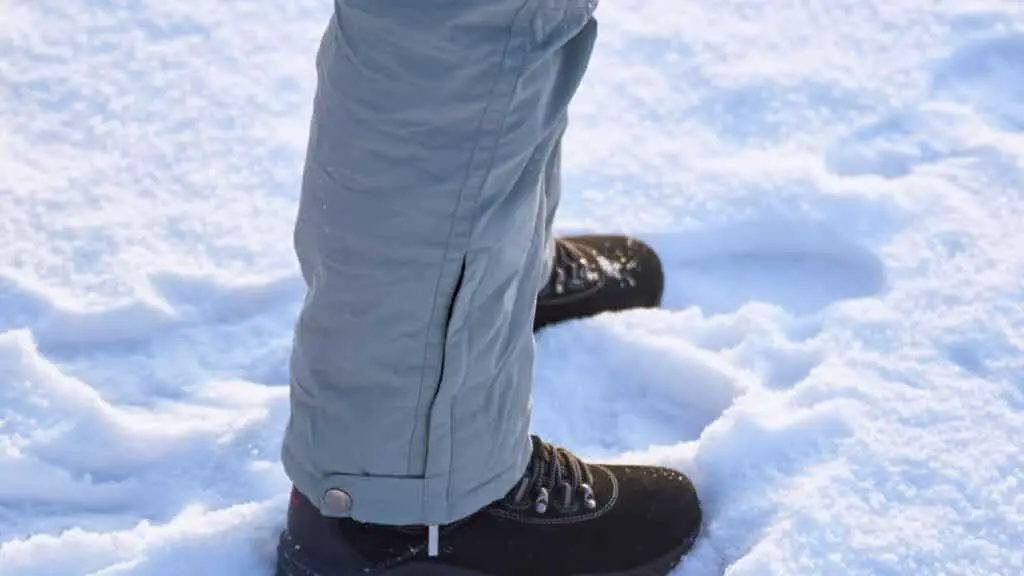
You can usually get by with moisture wicking hiking pants, long johns, and waterproof gaiters in moderately cold temperatures. The only time you need insulated hiking pants is when you’re camping in extremely cold weather.
It’s not worth spending the extra money on dedicated winter hiking pants. Any pair of comfortable water repellent snow pants will work. I use a pair of snowboarding pants whenever I’m camping in cold weather.
I wear a cheap pair of Arctix Snow pants and they’re good enough for my needs. They work down to 0°F, waterproof, windproof, and have built in gaiters. It would be nice if they had more pockets, but I can’t complain since they’ve held up for years.
Other Accessories: Winter Hats, Goggles/Glasses, Gaiters and Gloves or Mittens
- Winter Gloves or Mittens: I like to carry a light pair of gloves for dexterity, heavy gloves for hiking, and a pair of mittens to sleep in. Whether or not I carry all 3 depends on if I’m going for an ultralight/lightweight setup, but it’s nice to have options.
- Winter Hat or Beanie: The claim that you lose 50% of your body heat through your head is a myth, but you still need to protect your head. You lose about 10% of body heat through your head, but frostbite on your ears is a much bigger concern.
- Goggles or Sunglass: Your goggles/sunglasses serve 2 purposes. They keep snow and wind out of your eyes and cut down surface glare on the snow. I usually wear sunglasses, but have a pair of goggles for extreme weather.
- Insulated Gaiters (optional): Waterproof insulated gaiters aren’t necessary if you’re wearing insulated snow pants, but you will need them if you’re only wearing hiking pants. They’re your only line of defense for keeping snow out of low/mid heigh hiking boots.
- Snowshoes: Anybody that’s tried hiking in deep snow understands the importance of snow shoes. Hiking 1 mile through deep snow is like walking 5 in the summer. Snowshoes lift you up out of the snow making winter hiking much easier.
